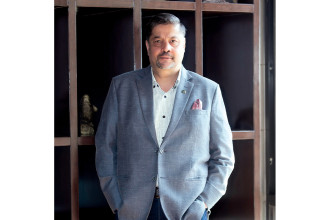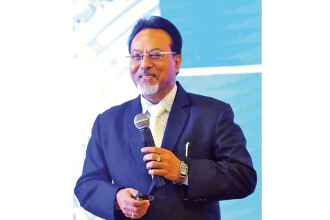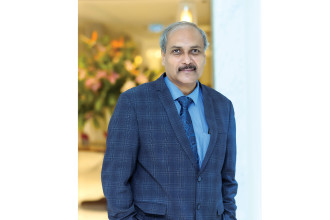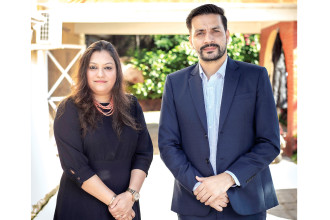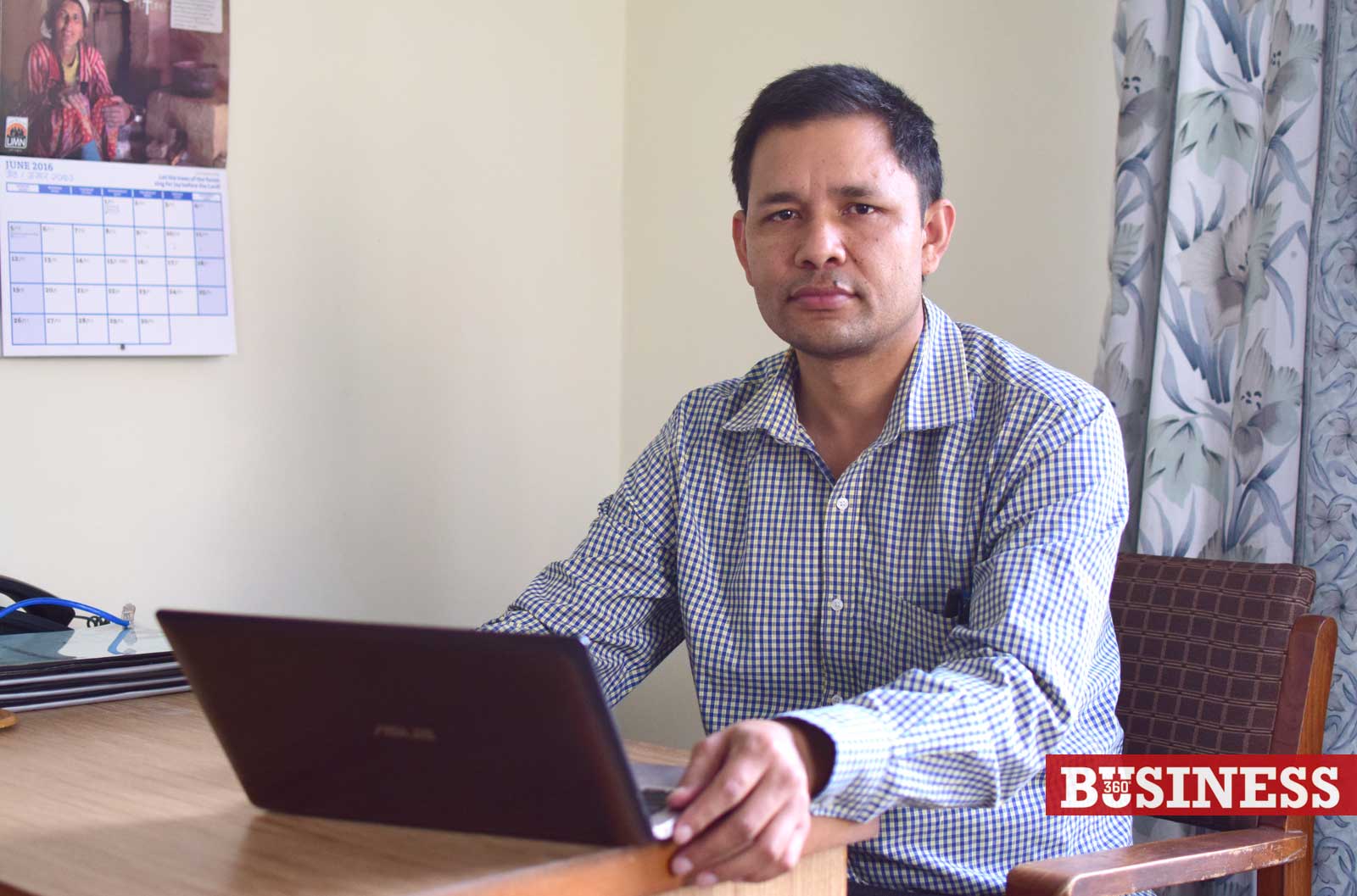
Community Self Reliance Center (CSRC), since its inception in 1993, has been working on the single issue of land and agrarian rights campaign in the country. The not-for-profit rights based center works to transform discriminatory and unjust social relations by organising landless, land poor and marginalised communities to claim and exercise their rights. CSRC following the mega earthquake of April 2015 rushed towards relief and recovery works which it has now redesigned into number of reconstruction and rehabilitation projects. Since the earthquake, the institution has already conducted more than half a dozen projects - both short-term and medium term - based on hardware and software support in more than six districts among the 14 most affected catering to more than 10,000 affected families with needs ranging from food, shelter, clothing, cash to skill and awareness development programmes. While conducting all of its emergency projects, CSRC has strongly pushed for the agenda of lands in the reconstruction process. Ashok Thapa from Business 360º talked to Jagat Deuja, Executive Director of CSRC to explore the link between land related issues and the government-announced reconstruction, and also learn why the issue of land is critical at this time. Excerpts:

CSRC has been lobbying that the issue of land should be taken into full consideration during the reconstruction process. What does this mean?
CSRC has been working on a single agenda of land for the last two decades. We also began works towards emergency relief and recovery following last year’s disastrous earthquake. During this time, we learnt and realised that the issue of land is strongly associated with reconstruction, and hence we began our advocacy in this direction. The loss we suffered due to the earthquake, to some extent, also relates with the issues of governance, including those of the distribution of property and resources. Considering all these we concluded that the reconstruction works cannot be effective unless the issue of land is integrated. We conducted studies in 14 districts that were most affected by the earthquake and found that there are as much as 7,000 landless families in these districts. On the other hand, 18,000 persons from 475 villages/communities have been replaced. This means they do not have lands and permanent shelters. Now the reconstruction means reconstruction of houses and their lives. Unless the reconstruction could benefit these displaced and landless population and people without legal land ownership status, the reconstruction process won’t be completed. It is hence, we have raised our voices to make sure that reconstruction process should benefit all the affected population.
CSRC has been working on a single agenda of land for the last two decades. We also began works towards emergency relief and recovery following last year’s disastrous earthquake. During this time, we learnt and realised that the issue of land is strongly associated with reconstruction, and hence we began our advocacy in this direction. The loss we suffered due to the earthquake, to some extent, also relates with the issues of governance, including those of the distribution of property and resources. Considering all these we concluded that the reconstruction works cannot be effective unless the issue of land is integrated. We conducted studies in 14 districts that were most affected by the earthquake and found that there are as much as 7,000 landless families in these districts. On the other hand, 18,000 persons from 475 villages/communities have been replaced. This means they do not have lands and permanent shelters. Now the reconstruction means reconstruction of houses and their lives. Unless the reconstruction could benefit these displaced and landless population and people without legal land ownership status, the reconstruction process won’t be completed. It is hence, we have raised our voices to make sure that reconstruction process should benefit all the affected population.
How can people who do not have legal land ownership status be included in the reconstruction process?
Primarily, reconstruction should not be mistaken with merely building the homes and shelters that were demolished by the earthquake. The houses, of course, should be made safer, stronger, more effective and inclusive, but more than that we should also correct our past mistakes. For example, reconstruction is also giving justice to people who suffered in the past due to unjust policies and exclusion. The government in its guidelines regarding the distribution of grant to the people who lost their homes due to the earthquake has made it mandatory that only those with citizenship and land ownership certificate would receive support to build their homes. Now those who do not have their own land or those who have been living in the lands of landlords would be prevented from the grant. Previously, the Nepal Reconstruction Authority (NRA) was in mood to first issue the grant to those who have their own lands and to come up with provisions later for those not having their own land. But following our repeated suggestions and pressures, they have agreed to provide public land to landless families and then to provide grant for building homes.
Primarily, reconstruction should not be mistaken with merely building the homes and shelters that were demolished by the earthquake. The houses, of course, should be made safer, stronger, more effective and inclusive, but more than that we should also correct our past mistakes. For example, reconstruction is also giving justice to people who suffered in the past due to unjust policies and exclusion. The government in its guidelines regarding the distribution of grant to the people who lost their homes due to the earthquake has made it mandatory that only those with citizenship and land ownership certificate would receive support to build their homes. Now those who do not have their own land or those who have been living in the lands of landlords would be prevented from the grant. Previously, the Nepal Reconstruction Authority (NRA) was in mood to first issue the grant to those who have their own lands and to come up with provisions later for those not having their own land. But following our repeated suggestions and pressures, they have agreed to provide public land to landless families and then to provide grant for building homes.
What exactly is the government doing for the landless?
The government is trying to address the problems of landless and displaced families in two different ways. Firstly, the government is building joint community-sort-of-hall, big in size, especially for the monsoon. The purpose is that the landless and displaced families could shift in the hall. This is the short term remedy. As the long term measure, the government is planning to provide land required for constructing homes in safe places for the landless and displaced people. The government has taken decision towards this effect; it however is yet to fix as to when this will be implemented.
The government is trying to address the problems of landless and displaced families in two different ways. Firstly, the government is building joint community-sort-of-hall, big in size, especially for the monsoon. The purpose is that the landless and displaced families could shift in the hall. This is the short term remedy. As the long term measure, the government is planning to provide land required for constructing homes in safe places for the landless and displaced people. The government has taken decision towards this effect; it however is yet to fix as to when this will be implemented.
What has the major learning been for CSRC after engaging in relief and recovery post-earthquake, more specifically in terms of reconstruction and rehabilitation?
Well that was an uncommon experience of such a huge natural calamity for the whole nation. Though there was confusion at all levels initially as to where and how to begin relief work, the humanitarian assistance carried out by development organistions is highly commendable. So the first learning was despite several warnings and predictions of the big quake, neither the government nor any other sectors seem to have remained alert or prepared. We also learnt that when any organisations go to the villages to support the people there, such aid should be in harmony with the efforts being made by the local organisations, clubs, mothers group and others local stakeholders. We have the trend of imposing support as per desire of the donors in whatever way they like, but this does not turn out to be effective. If we think we can win the hearts of people only through money and materials, we are absolutely wrong. On the other hand, during the emergency relief or reconstruction phase, if the support materials are distributed by creating groups/committees of the local people under the leadership of local stakeholders and with their guidance and cooperation, it bears effective outcome as these groups can be mobilised for identifying beneficiaries and distributing support adequately. This is how we can avoid duplication and give the beneficiaries a sense of ownership as well. The most important learning is that when distributing cash for work or other support, if they are handed over to female member of the families, chances are high that the support will be best utilised. This way women also feel a significant part of the society.
Well that was an uncommon experience of such a huge natural calamity for the whole nation. Though there was confusion at all levels initially as to where and how to begin relief work, the humanitarian assistance carried out by development organistions is highly commendable. So the first learning was despite several warnings and predictions of the big quake, neither the government nor any other sectors seem to have remained alert or prepared. We also learnt that when any organisations go to the villages to support the people there, such aid should be in harmony with the efforts being made by the local organisations, clubs, mothers group and others local stakeholders. We have the trend of imposing support as per desire of the donors in whatever way they like, but this does not turn out to be effective. If we think we can win the hearts of people only through money and materials, we are absolutely wrong. On the other hand, during the emergency relief or reconstruction phase, if the support materials are distributed by creating groups/committees of the local people under the leadership of local stakeholders and with their guidance and cooperation, it bears effective outcome as these groups can be mobilised for identifying beneficiaries and distributing support adequately. This is how we can avoid duplication and give the beneficiaries a sense of ownership as well. The most important learning is that when distributing cash for work or other support, if they are handed over to female member of the families, chances are high that the support will be best utilised. This way women also feel a significant part of the society.
What can be learnt to be better prepared for the future?
In my opinion, everybody knew that there would be a mega scale disaster long before the earthquake; of course nobody knew when it would happen. After the whole nation shook, it did not take us long to realise that our preparedness was very weak. The most worrisome fact is that I don’t think we have realised anything even after the quake. Hence, if there is another disaster like that of the last year, I am sure that we will have to go through the same cycle of suffering, problems and uncertainties. It is because we are very sluggish in the reconstruction aspect and the government has failed to give momentum to what it had promised. With regards to future preparatory action, it won’t suffice by only making the central level structures strong. There should be local level committees at the district and community levels who should be assigned to conduct interactions and discussions along with raising awareness among people about preparedness.
There should also be well-equipped and strong mechanisms at the local level government authority along with geography specific local level disaster plans. If such plans are readied and people are trained about how to remain safe during times of crisis, nothing would be much effective to minimise loss in the face of another disaster.
In my opinion, everybody knew that there would be a mega scale disaster long before the earthquake; of course nobody knew when it would happen. After the whole nation shook, it did not take us long to realise that our preparedness was very weak. The most worrisome fact is that I don’t think we have realised anything even after the quake. Hence, if there is another disaster like that of the last year, I am sure that we will have to go through the same cycle of suffering, problems and uncertainties. It is because we are very sluggish in the reconstruction aspect and the government has failed to give momentum to what it had promised. With regards to future preparatory action, it won’t suffice by only making the central level structures strong. There should be local level committees at the district and community levels who should be assigned to conduct interactions and discussions along with raising awareness among people about preparedness.
There should also be well-equipped and strong mechanisms at the local level government authority along with geography specific local level disaster plans. If such plans are readied and people are trained about how to remain safe during times of crisis, nothing would be much effective to minimise loss in the face of another disaster.
How do you view the performance of Nepal Reconstruction Authority (NRA) in context to donor pledge?
We have suffered a huge setback when it comes to the works of NRA even before it began its formal proceedings. This is not a positive sign. Unless we reconsider the leadership of the NRA, very less can be expected from this body. On the other hand, there is a problem with the working procedure. The government has decided to provide grants to construct around 700,000 individual homes. But its biggest mistake is that it has demanded grant-seekers not to lay the foundation stone unless an agreement is signed between the two parties. This will only add to the woes of the victims. Instead the government should have asked people to build their homes in a safer and stronger manner by providing them technical training and knowledge and by assuring that they will receive the grants upon construction of their home. But the way that the government is intending to give the amount on installments will not bear the intended results. The donor community does not seem to want to invest more unless some works are actually accomplished.
We have suffered a huge setback when it comes to the works of NRA even before it began its formal proceedings. This is not a positive sign. Unless we reconsider the leadership of the NRA, very less can be expected from this body. On the other hand, there is a problem with the working procedure. The government has decided to provide grants to construct around 700,000 individual homes. But its biggest mistake is that it has demanded grant-seekers not to lay the foundation stone unless an agreement is signed between the two parties. This will only add to the woes of the victims. Instead the government should have asked people to build their homes in a safer and stronger manner by providing them technical training and knowledge and by assuring that they will receive the grants upon construction of their home. But the way that the government is intending to give the amount on installments will not bear the intended results. The donor community does not seem to want to invest more unless some works are actually accomplished.
What do you think should be the modality of reconstruction?
Reconstruction is not only about building homes in substitution of those destroyed. It’s also not only about building back better and stronger. Rather reconstruction is also about correcting past mistakes and weaknesses. For instance, you build a strong home but there is violence against women in the same house. What’s the point of that house? You construct a huge and sophisticated school building, but the quality of education is not at par. What’s the benefit of such building? We develop good roads and canal networks in the villages but the women and marginalised are still in exclusion. What’s the use of such development? There has been a growing discussion on integrated settlement. We cannot afford at present huge integrated settlements, yet we can begin with few small and model integrated settlements. This will help save development cost. Creation of jobs and development of entrepreneurship in rural areas should be given top priority. The essence of reconstruction should be to enhance local economy while reconstruction should always be in the leadership of the community people and it should be based on the needs and choices of the community people but should not imposed by I/NGOs. Only then it will have some meaning of reconstruction. But at present, our debates have not been directed in this direction. For us reconstruction is merely building and rebuilding, which is totally wrong. Reconstruction should be all pervasive and should be able to change the face and future of the country.
Reconstruction is not only about building homes in substitution of those destroyed. It’s also not only about building back better and stronger. Rather reconstruction is also about correcting past mistakes and weaknesses. For instance, you build a strong home but there is violence against women in the same house. What’s the point of that house? You construct a huge and sophisticated school building, but the quality of education is not at par. What’s the benefit of such building? We develop good roads and canal networks in the villages but the women and marginalised are still in exclusion. What’s the use of such development? There has been a growing discussion on integrated settlement. We cannot afford at present huge integrated settlements, yet we can begin with few small and model integrated settlements. This will help save development cost. Creation of jobs and development of entrepreneurship in rural areas should be given top priority. The essence of reconstruction should be to enhance local economy while reconstruction should always be in the leadership of the community people and it should be based on the needs and choices of the community people but should not imposed by I/NGOs. Only then it will have some meaning of reconstruction. But at present, our debates have not been directed in this direction. For us reconstruction is merely building and rebuilding, which is totally wrong. Reconstruction should be all pervasive and should be able to change the face and future of the country.
Published Date: July 14, 2016, 12:00 am
Post Comment
E-Magazine
RELATED Face 2 Face



